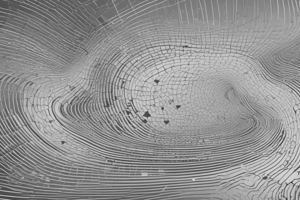Podcast
Questions and Answers
What is a characteristic that distinguishes vectors from scalars?
What is a characteristic that distinguishes vectors from scalars?
- They are always positive
- They have magnitude and direction (correct)
- They can be added and subtracted
- They can be scaled
Which of the following is an example of a displacement vector?
Which of the following is an example of a displacement vector?
- The change in position of an object (correct)
- The acceleration of an object
- The time it takes for an object to move
- The velocity of a car
What is a property of scalars?
What is a property of scalars?
- They have direction
- They can be added and subtracted using simple arithmetic (correct)
- They require trigonometry and geometry to operate
- They can be resolved into components
What is an example of a scalar?
What is an example of a scalar?
How can vectors be manipulated?
How can vectors be manipulated?
Study Notes
Vector Quality
- Magnitude and Direction: Vectors have both magnitude (amount of movement) and direction (orientation in space).
- Properties:
- Can be added and subtracted using the head-to-tail method or parallelogram method.
- Can be scaled (multiplied by a number).
- Can be resolved into components (broken down into smaller vectors).
- Types of Vectors:
- Displacement vectors: Represent the change in position of an object.
- Velocity vectors: Represent the rate of change of displacement.
- Acceleration vectors: Represent the rate of change of velocity.
Scalar Quality
- Magnitude only: Scalars have only magnitude (amount of something) but no direction.
- Properties:
- Can be added and subtracted using simple arithmetic.
- Can be scaled (multiplied by a number).
- Do not have direction, so they cannot be resolved into components.
- Examples of Scalars:
- Time
- Temperature
- Mass
- Energy
- Speed (note: speed is a scalar, while velocity is a vector)
Key Differences
- Vectors have direction, while scalars do not.
- Vectors can be resolved into components, while scalars cannot.
- Vectors require trigonometry and geometry to operate, while scalars use simple arithmetic.
Vector Quality
- Vectors have both magnitude (amount of movement) and direction (orientation in space).
- Vectors can be added and subtracted using the head-to-tail method or parallelogram method.
- Vectors can be scaled (multiplied by a number).
- Vectors can be resolved into components (broken down into smaller vectors).
- Displacement vectors represent the change in position of an object.
- Velocity vectors represent the rate of change of displacement.
- Acceleration vectors represent the rate of change of velocity.
Scalar Quality
- Scalars have only magnitude (amount of something) but no direction.
- Scalars can be added and subtracted using simple arithmetic.
- Scalars can be scaled (multiplied by a number).
- Scalars do not have direction, so they cannot be resolved into components.
- Examples of scalars include time, temperature, mass, energy, and speed.
Key Differences
- The main difference between vectors and scalars is that vectors have direction while scalars do not.
- Vectors can be resolved into components, while scalars cannot.
- Vectors require trigonometry and geometry to operate, while scalars use simple arithmetic.
Studying That Suits You
Use AI to generate personalized quizzes and flashcards to suit your learning preferences.
Description
Learn about the fundamental properties of vectors, including magnitude, direction, addition, and scaling. Understand the different types of vectors, such as displacement and velocity vectors.




